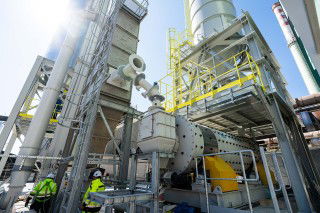Financial analysts CIC-Market Solutions (CMS) forecasts a decline in European construction activity, especially in France where new property builds are expected to dip. "The property market, traditionally the first sector of the real economy to be affected by monetary tightening policies, is bearing the full brunt of the combined effect of rising interest rates and higher factor costs, as well as the government's half-hearted efforts to support activity," said the French analysts. "After the post-COVID recovery, we expect construction investment [in France] to fall by 0.8 per cent in 2023 and 2.5 per cent in 2024," added CMS.
Similarly, Euroconstruct expects a cooling of the construction market and predicts a negative trend in construction spending not only in France but across Europe. For the EU-15, this revision stands at -1.3 per cent in 2023 and -0.7 per cent in 2024, compared with last November's positive forecasts. By segment, the sharpest downward revision concerns new housing, which is now expected to fall by -5.8 per cent (previous forecast of -2 per cent) in 2023 and by -2.7 per cent in 2024.
Euroconstruct’s outlook for renovation has also been revised down, albeit less sharply than for new housing, to -1.8 per cent in 2023 and -3.7 per cent in 2024. By country, there is a deterioration in the outlook for Germany (-2.2 per cent and -2.6 per cent in 2023 and 2024, compared with November's estimates of +0.4 per cent and +0.1 per cent, respectively) as a result of the abolition of certain subsidies (Förderungen). Italy has also been scaled back in 2023 (-0.5 per cent compared with +0.5 per cent in the previous scenario, with the expected contraction remaining at six per cent in 2024) due to the reduction in renovation subsidies (superbonus).
Purchasing power and new housing decline
Since July 2022 households' property purchasing power in France has fallen by 25 per cent. The measures against inflation taken by the European Central Bank led to seven straight key rate hikes and the 25-year mortgage rate rose from 2.44 per cent to 3.69 per cent on average. The current period has provided yet another opportunity to demonstrate the high sensitivity of new housing to rising interest rates, claims CMS. This segment, which has benefited from tax incentives over the last two decades, is now the poor relation of the sector, as shown by the latest leading indicators, which will take effect next year on construction production. Overall, CMS expect only a limited fall in new housing output in 2023 due to transmission delays (-2.5 per cent), but a more substantial fall in 2024 (-12 per cent versus 2023E).
French construction
Permits in France were down 30 per cent in the first four months of 2023, reflecting the difficulties in the upstream sector, as well as a 2022 base effect (482,000 units) boosted by property developers' desire to escape RE 2020 regulations. There is clearly a return to more normal values. Housing starts fell by 14.8 per cent over the first four months of the year, benefitting from a favourable comparison base, particularly in April, when soaring energy prices and construction costs had led to a wait-and-see attitude on the part of builders.
Rehabilitation accounts for 44 per cent of French construction. Improvement-maintenance grew by two per cent in 2022 and CMS now expect a slowdown in 2023 (+0.5 per cent). Non-residential construction accounts for 13 per cent of industry investment and remains firmer than housing. In 2023 production in the non-residential segment, fuelled by the backlogs created in 2021-22, should rise by +1.7 per cent in constant euros. It is expected to fall slightly in 2024 (by three per cent taking into account completion deadlines). The perceptible slowdown in demand for industrial premises (28 per cent of new non-residential construction) is being offset by the surprising resilience in the office sector (25 per cent of activity) and administrative buildings (29 per cent of non-residential production). Meanwhile, public works accounts for 22 per cent of construction boosted by civil engineering. "After the fall recorded in 2022 (-6.4 per cent), 2023 and 2024 are looking better, despite concerns expressed at the start of the year," claims CMS.
Building material price trends
Cement prices have reacted to the drop in the construction demand. "The deferral effect of the increases implemented last October and November has been fully felt, while the increases announced by Ciments Calcia (Heidelberg Materials Group) and Vicat for April have not been applied," said CMS. "In Belgium, prices have fallen marginally in sequential terms (-2 per cent), and a little more in Germany." In addition, Lafarge France (Holcim), which had not announced any price increases at the start of 2023, seems to be relying a little more on volumes.
For ready-mixed concrete prices, CMS estimate a rise of close to +23 per cent in April 2023 when compared with April 2022. Cement volumes in Germany, France and Belgium contracted by between -10 and -15 per cent compared to the first four months of 2022. Spain held up better (-3.2 per cent over the same period, but with an initial decline in April, at -15.8 per cent). Aggregate volumes were down 7.5 per cent due to roadworks. Ready-mixed concrete volumes were also down 6.8 per cent.
Holcim managed to buck the trends in the 1Q23 with a 0.3 per cent rise in cement sales volumes in Europe compared to the 1Q21. Vicat also saw consolidated sales in France increase by six per cent in the 1Q23, YoY. However, Vicat's European consolidated sales perhaps showed the first signs of weakness down 9.2 per cent YoY.
